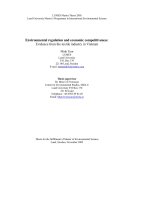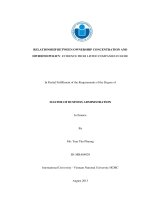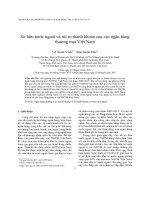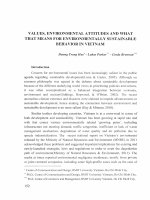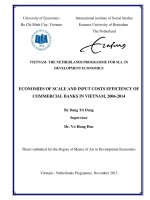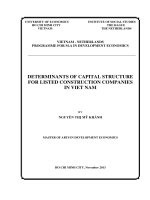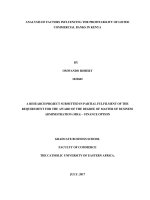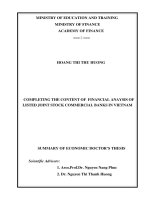Ownership complexity and loan quality: Evidence for listed commercial banks in Vietnam
Bạn đang xem bản rút gọn của tài liệu. Xem và tải ngay bản đầy đủ của tài liệu tại đây (246.9 KB, 5 trang )
ISSN 1859-1531 - THE UNIVERSITY OF DANANG - JOURNAL OF SCIENCE AND TECHNOLOGY, VOL. 19, NO. 12.1, 2021
47
OWNERSHIP COMPLEXITY AND LOAN QUALITY: EVIDENCE FOR
LISTED COMMERCIAL BANKS IN VIETNAM
Phan Hoang Long*
The University of Danang - University of Economics
*
Corresponding author:
(Received: September 27, 2021; Accepted: October 18, 2021)
Abstract - This paper examines the relationship among aspects
of bank ownership complexity, including ownership dispersion
and type, and the quality of bank loan portfolio. The data used
for analysis is an unbalanced panel consisting of 13 listed
commercial banks in Vietnam for the period of 2010 - 2019. The
non-performing loan (NPL) ratio is used as an indicator of loan
quality. The results showed that ownership dispersion,
calculation based on the Herfindahl–Hirschman Index of large
shareholding, improves the loan quality. Foreign ownership is
also found to have positive impact on the loan quality. However,
there is no relationship established between government
ownership and loan quality.
Key words - Bank ownership complexity; loan quality;
government ownership; foreign ownership; Vietnam
1. Introduction
The ownership structure of a commercial bank,
especially a publicly listed one, could be very complex. For
example, a part of the bank could be owned by the
government, other chunks by several foreign investors,
some other blocks by a number of large domestic investors,
and the rest by thousands of small individuals or passive
institutions. The extant literature has documented that the
ownership structure of the bank significantly influences its
risk taking. Specifically, different types of ownership (i.e.
government, foreign, or private) are found to have distinct
impacts on the level of bank risk taking due to the diversity
in goals and governance capability of these types of
shareholder [1, 2, 3]. For example, the government
ownership could encourage the bank to take on more risk
because of potential government subsidization [1]. The
dispersion of ownership (i.e. whether there are multiple
influential stockholders or there is just one controlling one)
is also documented to affect bank corporate governance,
thus having a significant impact on risk taking [4, 5, 6].
The results of these studies, however, have been mixed.
For example, Shehzad et al. [5] finds that ownership
dispersion is positively related to bank risk taking while
Bian and Deng [4] find the opposite. Also, Lassoued et al.
[1] and Dong et al. [2] document different impacts of foreign
ownership on risk taking. Another issue is that prior studies
often examine the ownership type and dispersion
separately even though bank ownership complexity arises
from both factors (i.e. the ownership structure becomes
more complex when there are more types of investors and
more dispersion among their ownership). As a result, more
investigations on this topic are needed. This paper aims to
bridge the gap in the literature by providing additional
empirical evidence on the relationship between bank
ownership complexity (reflected through both ownership
type and dispersion) and risk taking. This is an important
relationship because if banks take risk excessively, the
stability of the financial system will be threatened [6, 7].
This paper is also the first study on ownership complexity
and loan quality in Vietnam.
The analysis in this paper focuses on credit risk taking,
measured by loan quality. The quality of bank loans is an
important issue. Commercial lending provides the main
source of income for commercial banks and bad loans is a
major risk facing the banking system. This fact is even
more relevant in the context of Vietnam as the amount of
problematic loans reported to have surged 45% in the first
quarter of 2020 alone, which could negatively affect the
rating outlook of the banking sector [8]. Therefore, the
topic of this research is critical and our results could bear
pertinent implications for improving the loan quality of
banks in Vietnam.
2. Literature review and hypothesis development
2.1. Bank ownership dispersion and loan quality
The extant literature suggests two opposite effects that
ownership dispersion may face towards the loan quality.
The agency theory proposes that bank management have
the tendency to take on more risk in order to increase
potential returns, which their compensations and
promotions are based on [5, 9]. Shareholders, on the
contrary, should support prudent risk taking in order to
protect their investments in the bank. Thus, if the control
of the bank is concentrated in the hand of one dominant
shareholder (i.e. minimal ownership dispersion), this
shareholder has the power to monitor and take disciplinary
actions against the bank management if he feels that they
are taking risk excessively [9]. In this case, less dispersed
ownership increases lending oversight and improves the
quality of the bank’s portfolio of loans [5, 10].
On the other hand, the controlling shareholder may
have other interests outside of the bank, such as stakes in
other companies or personal relationships with their
managers [5]. In such cases, the controlling shareholder
may divert resources from the bank to bankroll his other
interests. The absence of other influential shareholders can
make it easier to do so [6]. For example, the controlling
shareholder may pressure management, without much
objection from other minority shareholders, to approve
otherwise unqualified loans to firms connected to him [5,
6]. This line of argument suggests that higher ownership
dispersion can help provide a check-and-balance system
48
among shareholders, thereby improving lending practices
and reducing bad loans.
It is also argued that the banking sector, due to its
importance to the economy, is heavily regulated by the
government. As a result, the risk taking practice of bank
managers will be closely monitored and disciplined by
banking regulators [5]. In this respect, the monitoring role
of shareholders is overshadowed by that of the
government. This could lead to an insignificant
relationship between ownership dispersion and loan
quality.
Previous empirical results on the relationship between
ownership dispersion and loan quality have been
inconclusive, supporting either a positive or negative
relationship. Bian and Deng [4], Goucha et al. [11] show
that a higher ownership dispersion is associated with a
lower non-performing loan (NPL) ratio, a reverse indicator
of loan quality. Bian and Deng [4] also provide evidence
supporting the argument that banks with lower ownership
dispersion tend to offer sizable loans to firms related to the
controlling shareholders. These results support the checkand-balance effect of ownership dispersion. On the
contrary, Shehzad et al. [5] document that a higher
concentration of ownership reduces the NPL ratio. The
authors suggest that more dispersion reduces the
effectiveness of shareholders in monitoring lending
practices. This evidence supports the positive role of the
controlling shareholder. Based on these evidences, the
following alternative hypotheses are proposed:
H1a: Ownership dispersion improves loan quality.
H1b: Ownership dispersion deteriorates loan quality.
2.2. Government ownership and loan quality
Most of the prior studies show that government
ownership is associated with more credit risk taking.
Iannotta et al. [3] find that large European banks with
government ownership is associated with higher credit
risk. Lassoued et al. [1] show that government ownership
encourages banks to take on more credit risk. Dong et al.
[2] document that government-owned banks in China have
higher NPL ratios. Angkinand and Wihlborg [12] provide
similar evidence for other emerging markets.
The literature suggests several reasons for the negative
impact of the government as a shareholder on the bank’s
credit risk taking practice. First, the government is likely to
protect government-owned banks from losses by providing
financial subsidies or regulatory support [1, 13]. Thus,
government-owned banks are induced to take on more risk
since the cost will be bear by the government rather than
by the bank shareholders [12]. Second, it is possible that
managers of government - owned banks approve
substandard loans in exchange for bribes [1]. Third,
government-owned banks can be pressured by politicians
to lend to high-risk projects that serve social or political
purposes, or benefit the politician’s own interests [2, 6]. In
emerging markets, these effects could be more pronounced
[2, 12]. Based on these arguments, the following
hypothesis is formed:
H2: Government ownership reduces loan quality.
Phan Hoang Long
2.3. Foreign ownership and loan quality
The presence of foreign investors can improve the
corporate governance of local banks. Specifically, foreign
investors bring about better risk management practice,
highly skilled banking professionals, and advanced
information technologies [1, 14, 15]. As a result, foreign
ownership can enhance the quality of loans. This argument
is especially relevant to emerging countries where the local
banking practice is under-developed.
On the other hand, foreign investors often face the
“liabilities of foreignness” as they may have difficulty
understanding and adopting to the local culture and
practice [15, 16]. They also lack the local connection. As a
result, foreign investors may not perform their monitoring
role as effectively as local ones and they could impose
credit policies that are unsuitable for the local market. This
could negatively impact on loan quality.
In fact, previous empirical evidence on the effect of
foreign ownership has on loan quality are mixed. Dong et
al. [2], Angkinand and Wihlborg [12] find an insignificant
relationship between foreign ownership and loan quality.
On the other hand, Lassoued et al. [1], Haque [15], and
Berger et al. [17] report that foreign ownership improves
loan quality. These evidences lead to the following
alternative hypotheses being proposed:
H3a: Foreign ownership improves loan quality.
H3b: Foreign ownership reduces loan quality.
3. Data and method
The panel regression model is as below:
NPLi,t = β0 + β1Dispersioni,t + β2GovOwni,t
+ β3ForOwni,t + β4Sizei,t + β5LDRi,t
+ β6LoanGri,t + β7DepositGri,t
+ β8FemaleDiri,t + εi,t
Where, i denotes the bank and t the year. Following the
literature, bank loan quality is reversely indicated by the
NPL ratio (NPL) [1, 2], calculated as the amount of nonperforming loans divided by the amount of total
outstanding loans. Bank ownership complexity is jointly
indicated by ownership dispersion (Dispersion),
government ownership (GovOwn) and foreign ownership
(ForOwn). Dispersion is calculated as one minus the
Herfindahl–Hirschman Index of large shareholding. This is
a popular measure of complexity [4]. Specifically:
𝐷𝑖𝑠𝑝𝑒𝑟𝑠𝑖𝑜𝑛 = 1 −
(∑𝑗=1..𝑛 𝑠ℎ𝑎𝑟𝑒𝑗2 )
2
(∑𝑗=1..𝑛 𝑠ℎ𝑎𝑟𝑒𝑗 )
Where, n is the number of influential shareholders whose
ownership (share, calculated in percentage) exceeds 5%
the bank’s total outstanding shares. Related shareholders,
i.e. family members or related institutional investors, are
combined into one shareholder representing one group of
interest. The value of Dispersion is 1 if there is no
influential shareholder (i.e. the bank ownership is complex,
being dispersed among numerous small shareholders), is 0
if there is only one controlling shareholder, and is between
0 and 1 when there are more than one large shareholder.
ISSN 1859-1531 - THE UNIVERSITY OF DANANG - JOURNAL OF SCIENCE AND TECHNOLOGY, VOL. 19, NO. 12.1, 2021
0.015
-0.046
-0.089
0.214*
-0.027
*, **: p< 5%, 1%
-0.03
FemaleDir -0.281**
0.443**
0.670**
-0.319**
-0.124
-0.118
-0.119
DepositGr 0.176
-0.014
-0.169
0.069
-0.229*
-0.091
0.192
LoanGr
0.074
0.443**
0.145
0.046
0.101
LDR
-0.125
0.319**
-0.308**
Size
0.078
-0.391**
ForOwn
0.610**
0.112
0.147
-0.382**
GovOwn
0.428**
1
Dispersion -0.375**
NPL
1
1
Dispersion GovOwn
1
ForOwn
1
Size
1
LDR
1
LoanGr
1
1
DepositGr FemaleDir
Table 2. Correlation matrix
NPL
GovOwn is a dummy variable that takes the value of 1 if
the government owns an influential share of the bank and
0 otherwise. ForOwn is a dummy variable that takes the
value of 1 if there is an influential foreign shareholder and
0 otherwise.
The control variables include the size of the bank (Size),
calculated as the natural logarithm of total asset (in billion
VND), the loan-to-deposit ratio (LDR), the loan growth
rate (LoanGr), and deposit growth rate (DepositGr). I also
control for the number of female directors (FemaleDir) as
a proxy of bank governance, since Dong et al. [2] show that
female directors on the board reduce bank risk taking. Year
fixed effects are included to account for time-variant
factors. Bank fixed effects are not included. The reason is
that the bank ownership complexity indicators do not vary
much over time. As a result, adding bank fixed effects can
lead to imprecise estimates [18].
To empirically test the model, I collect data for all
13 listed commercial banks in Vietnam for the period of
2010-2019. Listed banks are chosen for this analysis since
they have more available, and also more reliable data than
unlisted ones because of the reporting requirements by the
exchanges (most of the banks in the sample are audited
by Big4 audit firms). Furthermore, the ownership of
unlisted banks is normally concentrated in the hand of
the government or a private family. Financial data is
collected from FiinPro, a large financial data provider in
Vietnam. The detailed ownership structure is extracted
from Reuter Refinitiv, an international research data
provider, and is cross checked with the banks’ financial
statements. The final unbalanced panel data consists of
93 bank-year observations. Table 1 presents the
descriptive statistics of the data. There are some sizable
loan/deposit growth rates (around 100%) due to the
mergers of banks (for example, in 2012 SHB Bank
merged with Habubank, thus the 93.4% loan growth and
95.9% deposit growth rates). This does not present a
problem to my analysis because the results remain
qualitatively similar when I exclude LoanGr and
DepositGr from the control variables.
49
Table 1. Data description
Variable
N
Mean
Std. Dev.
Min
Max
NPL
93
0.020
0.014
0.003
0.088
Dispersion
93
0.326
0.310
0
1
GovOwn
93
0.387
0.490
0
1
ForOwn
93
0.430
0.498
0
1
Size
93
12.429
0.957
9.904
14.214
LDR
93
0.884
0.160
0.594
1.380
LoanGr
93
0.197
0.156
-0.027
0.934
DepositGr
93
0.192
0.209
-0.327
1.199
FemaleDir
93
1.763
1.228
0
5
Table 2 shows the pairwise correlation matrix of
the variables. No correlation between any two variables
is higher than 0.8, alleviating the concern about multicollinearity. The VIF result (untabulated) further confirms
this.
4. Results and discussion
Table 3 presents the regression results. Column 1 to
3 show the results without controls and column 4
illustrates the result for the full model. I discuss the full
model result in column 2. The coefficient for Dispersion
is -0.010 and is statistically significant at the 5% level.
This indicates that higher ownership dispersion is
associated with better loan quality (lower NPL). Thus,
hypothesis H1a is confirmed. This result supports Bian
and Deng’s [4] notion that in emerging countries where
shareholder protection is weak, the controlling
shareholders may tunnel resources away from minority
shareholders. This is often disguised in the form of low
quality loans to related firms. To demonstrate the
economic significance, one standard deviation increase in
Dispersion (0.326, see Table 1) will lead to a decrease of
0.3% (0.326×0.010) in NPL, a 15% reduction from the
average NPL of 2% (see Table 1).
50
Phan Hoang Long
Table 3. Regression results
Dispersiont
(1)
-0.024**
(-4.02)
Dep. Var. = NPLt
(2)
(3)
-0.014**
(-4.74)
GovOwnt
-0.015**
(-4.64)
ForOwnt
Sizet
LDRt
LoanGrt
DepositGrt
FemaleDirt
Fixed effects
N
R2
Year
93
23.42%
Year
93
23.03%
Year
93
24.84%
(4)
-0.010*
(-2.26)
-0.006
(-1.15)
-0.009*
(-2.57)
-0.003
(-1.06)
0.041*
(2.01)
0.020
(1.11)
0.014
(1.30)
-0.003*
(-2.59)
Year
93
53.71%
foreign ownership lowers NPL by 0.9%, a 45% reduction
from the average NPL.
Regarding the results for the control variables, LDR is
positively related to NPL, indicating that banks with higher
loan-to-deposit ration generally have lower loan quality.
This is understandable as those banks seem to be willing to
take more risk to expand their loan portfolios. FemaleDir
is negatively related to NPL. This is consistent with the
previous result by Dong et al. [2] showing that female
directors improve risk taking.
A robustness test is conducted to further confirm the
main result. To account for the potential issue of
endogeneity (i.e., NPL ratio can also simultaneously lead
to changes in the ownership structure and other
characteristics of the bank), I use the one-year lagged
independent variables instead of the contemporaneous
ones in the regression. Table 4 shows that the result
remains robust. The coefficients for the lagged Dispersion
and ForOwn are negative (-0.011 and -0.010 respectively)
and are significant at the 5% and 1% level, respectively.
Table 4. Robustness test
*, **: p< 5%, 1%. t-stat in parentheses.
The coefficient for GovOwn is negative and statistically
significant in column 2 but is insignificant in the full
model. This suggests that, in general, banks with
government ownership have better loan quality, but the
effect is more likely come from other factors such as the
loan-to-deposit ratio or ownership dispersion, not
government ownership itself. Thus, hypothesis H2 is
rejected. A possible explanation is that, in the case of
Vietnam, there are several forces that may positively
influence the relationship between government ownership
and loan quality. These forces could counter the potential
negative impacts of government ownership identified in
previous research, leading to an insignificant effect. First,
compared to private owned banks, government-owned
banks have the privileges of lending to bigger firms and
government subsidized firms. Those firms normally have
better risk profiles. Second, the State Bank of Vietnam
monitors the NPL ratio of government-owned banks very
closely due to their importance to the stability of the
banking system and the economy as a whole. This
discourages government-owned banks from taking
excessive credit risk. Third, even if the NPL ratio of a
government-owned bank is in fact high, the government
may pressure the bank to report a lower figure. This is to
avoid the public fear of a credit problem in the banking
system while the government works behind the scene to
solve the problem.
The coefficient for ForOwn is negative (-0.009) and
statistically significant at the 5% level in the full model.
This suggests that loan quality increases in the presence of
foreign shareholders. Therefore, H3a is supported. This
result is consistent with those reported by Lassoued et al.
[1] and Berger et al. [17]. It implies that foreign investors
play a positive role in improving the risk taking practice of
banks in Vietnam. To show the economic significance,
Dispersiont-1
(1)
-0.019**
(-3.30)
GovOwnt-1
ForOwnt-1
Sizet-1
LDRt-1
LoanGrt-1
DepositGrt-1
FemaleDirt-1
Fixed effects
N
R2
Year
91
17.51%
Dep. Var. = NPLt
(2)
(3)
(4)
-0.011*
(-2.21)
-0.012**
-0.002
(-3.91)
(-0.39)
-0.014** -0.010**
(-4.50)
(-2.79)
-0.004
(-1.36)
0.036
(1.86)
0.019
(1.15)
0.002
(0.15)
-0.005**
(-3.77)
Year
Year
Year
91
91
91
19.54% 23.27% 54.18%
*, **: p< 5%, 1%. t-stat in parentheses.
5. Conclusion
This paper examines the relationship between bank
loan quality and the aspects of bank ownership complexity,
namely ownership dispersion and ownership type. The
results for 13 listed commercial banks in Vietnam for the
period of 2010-2019 demonstrate that ownership
dispersion improves loan quality. Foreign ownership is
associated with better loan quality while no relationship is
found between government ownership and loan quality.
The results of this paper present several important
implications for shareholders and policy makers. First,
banks with concentrated ownership should be monitored
closely for the potential of excessive risk taking.
ISSN 1859-1531 - THE UNIVERSITY OF DANANG - JOURNAL OF SCIENCE AND TECHNOLOGY, VOL. 19, NO. 12.1, 2021
Furthermore, bank shareholders should advocate for more
diversified ownership in order to prevent the few powerful
controlling shareholders from engaging in expropriation,
possibly in the form of bad loans. The government should
also exercise stricter regulation to inhibit these activities.
Second, my analysis indicates that, on average, foreign
ownership reduces the percentage of bad loans by as much
as 45%. Thus, more foreign investments in local
Vietnamese banks should be facilitated to enhance the risk
taking practice, particularly of credit risk. Despite the fact
that the Vietnam government has become more and more
open to foreign investors, foreign ownership in the banking
sector remains limited by the law. Specifically, for
commercial banks in Vietnam, a particular foreign investor
cannot own more than 20% and total foreign ownership is
capped at 30%. This limit should be adjusted upward in the
future to allow for more foreign ownership.
This study, nevertheless, has a number of limitations.
First, the sample size is not very large due to the lack of
data available (some of the banks have been listed on the
exchange only recently), albeit 93 observations are enough
to ensure that the results are statistically meaningful.
Second, while the robustness test partly addresses the issue
of endogeneity, more tests, such as using instrumental
variables or GMM, are needed to fully alleviate the
concern. However, due to the limit of data size, those tests
are not feasible. Finally, this paper focuses only on bank
credit risk taking. Future studies could examine the impact
of ownership complexity on other important aspects of
bank operation, such as liquidity risk taking or operation
efficiency.
Acknowledgement: This research is granted by Funds of
the University of Danang - Development of Science and
Technology under project number B2019-DN04-28.
REFERENCES
[1] Lassoued, N., Sassi, H., Attia, M. B. R., “The impact of state and
foreign ownership on banking risk: Evidence from the MENA
countries”, Research in International Business and Finance,
Volume 36, 2016, pages 167-178.
[2] Dong, Y., Meng, C., Firth, M., Hou, W., “Ownership structure and
risk-taking: Comparative evidence from private and state-controlled
banks in China”, International Review of Financial Analysis,
[3]
[4]
[5]
[6]
[7]
[8]
[9]
[10]
[11]
[12]
[13]
[14]
[15]
[16]
[17]
[18]
51
Volume 36, 2014, pages 120-130.
Iannotta, G., Nocera, G., Sironi, A., “The impact of government
ownership on bank risk”, Journal of Financial Intermediation,
Volume 22(2), 2013, pages 152-176.
Bian, W., Deng, C., “Ownership dispersion and bank performance:
Evidence from China”, Finance Research Letters, Volume 22, 2017,
pages 49-52.
Shehzad, C. T., de Haan, J., Scholtens, B., “The impact of bank
ownership concentration on impaired loans and capital adequacy”,
Journal of Banking & Finance, Volume 34(2), 2010, pages 399-408.
Haw, I.M., Ho, S.S.M., Hu, B., Wu, D., “Concentrated control,
institutions, and banking sector: An international study”, Journal of
Banking & Finance, Volume 34(3), 2010, pages 485-497.
Laeven, L., Levine, R., “Bank governance, regulation and risk
taking”, Journal of Financial Economics, Volume 93(2), 2009,
pages 259-275.
Fitch Ratings, “Surging bad loans aggravate Vietnam banks' capital
challenges”, fitchratings.com, 2020, />research/banks/surging-bad-loans-aggravate-vietnam-bankscapital-challenges-06-05-2020, accessed on 22 May 2021.
Unite, A. A., Sullivan, M. J., “The effect of foreign entry and ownership
structure on the Philippine domestic banking market”, Journal of
Banking & Finance, Volume 27(12), 2003, pages 2323-2345.
Laeven, L., & Levine, R., “Complex Ownership Structures and
Corporate Valuations”, Review of Financial Studies, 21(2), 2008,
pages 579–604.
Goucha, N. B. S, Belaid, F., Omri, A., “Bank ownership concentration,
board of directors and loan portfolios' quality: evidence from the
Tunisian banking sector”, International Journal of Business
Performance Management, Volume 21(3), 2020, pages 329-345.
Angkinand, A., Wihlborg, C., “Deposit insurance coverage, ownership,
and banks' risk-taking in emerging markets”, Journal of International
Money and Finance, Volume 29(2), 2010, pages 252-274.
Faccio, M., Masulis, R. M., McConnell, J. J., “Political connections
and corporate bailouts”, Journal of Finance, Volume 61(6), 2006,
pages 2597–2635.
Berger, A. N., Hasan, I., Zhou, M., “Bank ownership and efficiency
in China: What will happen in the world’s largest nation?”, Journal
of Banking & Finance, Volume 33(1), 2009, pages 113-130.
Haque, F., "Ownership, regulation and bank risk-taking: evidence
from the Middle East and North Africa (MENA) region", Corporate
Governance, Volume 19(1), 2019, pages 23-43.
Kobeissi, N., Sun, X., “Ownership structure and bank performance:
evidence from the Middle East and North Africa region”, Comparative
Economic Studies, Volume 52(3), 2010, pages 287-323.
Berger, A. N., Klapper, L. F., Peria, M. S. M., Zaidi, R., “Bank
ownership type and banking relationships”, Journal of Financial
Intermediation, Volume 17(1), 2008, pages 37-62.
Ho, K., Wong, E., Tan, E., “Complexity of global banks and the
implications for bank risk: Evidence from foreign banks in Hong
Kong”, Journal of Banking & Finance, 2020, 106034.
